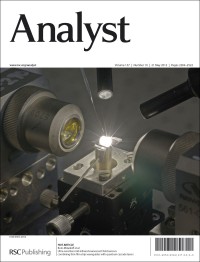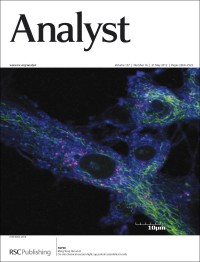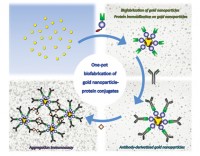Take a look at our latest issue, now available for you to browse.
Work from Editorial Board member Professor Boris Mizaikoff of the University of Ulm is on the front cover, the inside front cover shows a striking image related to a paper on protein visualisation, and the back cover highlights a strategy for fabrication of nanoparticle-protein conjugates.
Boris and his colleagues demonstrate ultra-sensitive chemical sensing in the mid-infrared spectral regime with a combination of quantum cascade lasers with strip waveguides fabricated via metal–organic vapor-phase epitaxy (MOVPE) and reactive ion etching (RIE) using evanescent field absorption spectroscopy. They say that this is among the most sensitive evanescent field absorption measurements with a miniaturized mid-infrared sensor system reported to date.
Ultra-sensitive mid-infrared evanescent field sensors combining thin-film strip waveguides with quantum cascade lasers
Xiaofeng Wang, Seong-Soo Kim, Robert Roßbach, Michael Jetter, Peter Michler and Boris Mizaikoff
Analyst, 2012, 137, 2322-2327
DOI: 10.1039/C1AN15787F
On the inside front cover is research from Ming-Yong Han of the Agency for Science, Technology and Research (A*STAR) in Singapore.
Dr Han and co-workers have developed a fast and effective method to visualize interactive proteins across intact cells via on-site formation of fluorescence. According to the authors, this labelling method provides new insights to comprehend important aspects of cellular functions of organelles and their relation to health imperfections for disease diagnostics and imaging-guided therapy.
On-site chemical reaction lights up protein assemblies in cells
Khin Yin Win, Choon Peng Teng, Michelle Low Bee Jin, Enyi Ye, Natalia C. Tansil and Ming-Yong Han
Analyst, 2012, 137, 2328-2332
DOI: 10.1039/C2AN16123K
The back cover features work from Kojiro Shimojo of the Japan Atomic Energy Agency and collaborators.
They report a one-pot biological one-pot strategy to fabricate highly stabilized, monodisperse gold nanoparticle–protein conjugates that can be readily derivatized with antibodies. The authors expect that their approach can be expanded to produce a variety of biomolecule-decorated nanoparticles with high affinity and specificity for target molecules.
Facile, rapid and efficient biofabrication of gold nanoparticles decorated with functional proteins
Kojiro Shimojo, Teppei Niide, Tomitsugu Taguchi, Hirochika Naganawa, Noriho Kamiya and Masahiro Goto
Analyst, 2012, 137, 2300-2303
DOI: 10.1039/C2AN35172B
All our cover articles will be free to access for 6 weeks.
Don’t forget to also take a look at the HOT articles in this issue.













